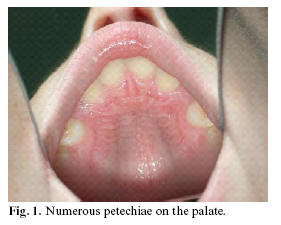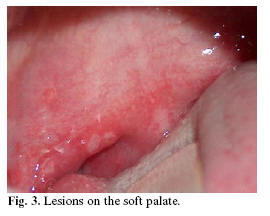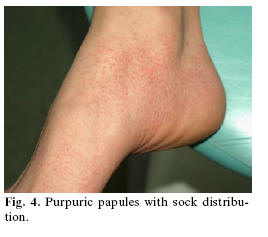Papular Purpuric Gloves and Socks Syndrome Red Ground Beef Hands
Papular purpuric gloves and socks syndrome. Presentation of a clinical case
Rafael Segura Saint-Gerons ane, Alejandro Ceballos Salobreña two, Pablo Gutiérrez Torres 3, Antonio González Ruiz four, Inmaculada Gavilán Fernández 5, Angel Martínez-Sahuquillo Márquez half-dozen
(ane) Primary Care Stomatologist. C.S. Peñarroya. Córdoba
(ii) Professor of Oral Medicine. Facultad de Odontología de Granada
(3) Pupil of Master in Oral Medicine. Sevilla
(iv) Dermatologist. Hospital Comarcal. Pozoblanco. Córdoba
(v) Primary Intendance Pediatrician. C.Southward. Peñarroya. Córdoba
(half-dozen) Graduate in Oral Medicine. Facultad de Odontología. Sevilla
Correspondence
ABSTRACT
Papular-Purpuric Glove-and-Sock Syndrome is a rare, communicable diseases, of viral etiology, characterized by the presence of pruritus, edema and symmetrical erythema, very well divers at the wrists and ankles with a gloves-and-socks distribution. Other areas can be affected, with a moderate erythema appearing in cheeks, elbows, knees, armpits, abdomen, groin, external genitalia, internal confront of the thighs and the buttocks. Erosions, small ulcers, enanthema and blisters can be observed in the oral fissure and lips, and less frequently in other mucous membranes. Complications are rare, although they tin can be severe, 50% of the published cases are related with the Parvovirus B19. Due to its oral involvement stomatologists should be aware of this syndrome in club to comport out a correct diagnosis of the disease.
Primal words: Glove and Sock Syndrome, Parvovirus B19, purpura.
RESUMEN
El Síndrome Papular Purpúrico en Guante y Calcetín es un síndrome raro, infeccioso, de etiología, viral que se caracteriza por la presencia de prurito, edema y eritema simétricos, muy bien delimitadas a nivel de las muñecas y de los tobillos con el aspecto en guante y calcetín. Pueden afectarse otras áreas apareciendo united nations eritema moderado en mejillas, codos, rodillas, axilas, abdomen, ingles, genitales externos, cara interna de muslos y glúteos. En la cavidad oral y labios y menos frecuentemente en otras membranas mucosas se pueden observar erosiones , pequeñas úlceras, enantema y vesículas. Las complicaciones son raras aunque pueden ser severas El 50% de los casos publicados están relacionados con el Parvovirus B19. La afectación oral en este síndrome hace que deba ser conocido por los estomatologos para realizar united nations correcto diagnostico de esta enfermedad.
Palabras clave: Síndrome en Guante y Calcetín, Parvovirus B19, púrpura.
Introduction
Papular-Purpuric Glove-and-Sock Syndrome is a rare disease, normally of infectious etiology, which, in addition to a cutaneous involvement, manifests with lesions in the oral cavity.
In 1990 Harms, Feldmann and Saurat described, in five Swiss patients (1), a papular dermatosis characterized by edema and erythema that evolved toward a petechial purpura with a characteristic glove and sock distribution. The etiology was unknown, although the authors suggested an infectious origin.
In 1991, Bagot and Revuz were the first authors to implicate the Parvovirus B19 in the etiology of this syndrome (2), and since then numerous studies have indicated its involvement in more than fifty% of cases (iii-7).
Parvovirus B19 is the only parvovirus that produces pathology in humans; information technology is a Deoxyribonucleic acid virus of the Parvoviridae family unit that infects the precursor cells of erythrocytes in bone marrow. It is usually contracted via respiratory secretions, fundamentally in childhood, and frequently produces a type of febrile exanthem known as erythema infectiosum or 5th disease (8). It tin can also produce acute or chronic arthropathies, fetal hydrops, abortions, aplastic anemias (9), hepatitis (x) or, much less frequently, Sjögren'due south syndrome (11) or papular-purpuric glove-and-sock syndrome.
This syndrome affects children or young adults, actualization equally in both sexes and appears fundamentally in leap and summer. The rash is usually accompanied by fever and is cocky limiting, disappearing in one or two weeks with a slight desquamation of the areas involved. Just symptomatic handling is required, relapses having not been described.
In the oral mucosa it presents every bit multiple petechiae on the difficult and soft palate and as pocket-sized erosions in the oral mucosa and natural language; commissural cheilitis can also nowadays.
Nonspecific urethritis can appear as other mucosal interest.
Diagnosis of this syndrome is made by the clinical dermatological characteristics and is confirmed by specific serology for Parvovirus B19 using enzyme-linked immunosorbent assay (ELISA), or polymerase chain reaction (PCR). Active infection is demonstrated by high IgM titers that subside over 2-4 weeks when an elevation in IgG appears.
The differential diagnosis should be made against urticaria-angioedema, serpiginous purpuric eruption of hands and feet, hand-foot-and-rima oris disease, exanthem subitum, or erythema infectiosum, which are as well produced by Parvovirus B19 (12).
Clinical Case
A 9 yr-sometime male person referred by his pediatrician for presenting a possible aphthous stomatitis accompanied by pruriginous lesions on the feet, hands and buttocks of 48 hours evolution.
On examination the patient appeared to be in generally very good health, although with febricula, and with petechial lesions in the oral cavity and erythema on the palate (Figure 1) equally well as aphthous lesions appearing on the floor of the mouth and ventral face of the tongue (Figure two), and the same blazon of lesions on the soft palate (Effigy three). The dermatological examination revealed a multitude of papular lesions of purpuric appearance on the feet (Figure four) and buttocks, these aforementioned lesions appearing much less numerously on the hands and axillae.




Too, the patient presented a urethritis with a slight purulent exudate from which a culture was made, resulting as normal flora.
Analytical tests where made, finding merely a moderate platelet deficiency equally well as serology to Herpes virus type I and II; Coxsackievirus and Cytomegalovirus, which were negative, and Parvovirus B19 being in this example IgM positive and IgG negative. Treatment with paracetamol was established.
At 10 days the patient was completely reestablished, all lesions, both oral and cutaneous, having disappeared without sequela.
For reasons beyond our command (summer vacations, beginning of school etc.) several months passed before seeing the patient again, at that fourth dimension taking the opportunity to repeat the serology to Parvovirus, the IgG titers being very loftier while those of IgM had essentially subsided.
In view of the clinical picture and of the patient's seroconversion for Parvovirus B19, a diagnosis of Papular-Purpuric Glove-and-Sock Syndrome was established.
Discussion
Papular-Purpuric Glove-and-Sock Syndrome is a rare clinical class of infection by Parvovirus B19. Since its description in 1990 by Harms, and since Bagot related it with this virus in 1991, this etiology has been demonstrated in 50% of the described cases. In other cases, other virus such as Herpes Virus type half dozen (13) Cytomegalovirus (14,fifteen) or Coxsackie B6 (13), bacteria such every bit Arcanobacterium haemolyticum (16) or drugs such as trimethoprim-sulfamethoxazole (17) have been implicated.
The pathogeny of this illness is not perfectly clarified, but in the case of Parvovirus infection, viral particles accept been isolated in vessel endothelium and in basal cells of the epidermis at the time of the exanthema. In spite of this, it is debated as to whether the clinical manifestations are a consequence of the viremia (xviii) or of circulating immunocomplexes (19).
The patient presented here constitutes a characteristic case of this syndrome, for reason of its typical clinical manifestation, its advent in leap and a perfectly demonstrated seroconversion.
It is important to carry out a differential diagnosis confronting hematological disorders, such equally aplastic anemia or Henoch-Schönlein purpura whose clinical and analytical findings will exist conclusive. Likewise, confronting viral infections such as measles, which affect the whole trunk and do not have the characteristic distribution of this syndrome, paw-pes-and-rima oris illness, and infectious mononucleosis in a higher place all if accompanied by cutaneous rash or herpangina. Some dermatologic syndromes such equally Gianotti-Crosti Syndrome or Kawasaki affliction should be included in the differential diagnosis.
In conclusion, Papular-Purpuric Glove-and-Sock Syndrome is a self-limiting acrodermatosis, of unknown pathogeny that fundamentally affects children and immature adults. It is characterized past edema and pruritus of hands and feet, followed by a purpura at the same site, involvement of the oral mucosa with erythema and petechiae, and some minimal alterations in the analyses. Parvovirus B19 is implicated equally the etiologic agent in 50% of the described cases, merely other etiologic agents can as well be involved.
References
1. Harms M, Feldmann R, Saraut J.H. Papular-purpuric "gloves and socks" syndrome. J Amer Acad Derm, 1990;23:850-4. [ Links ]
two. Bagot M, Revuz J. Papular-purpuric "gloves and socks" syndrome: primary infection with parvovirus B19? J Amer Acad Derm 1991;25: 341-ii. [ Links ]
iii. Harel L, Straussberg I, Zeharia A, Praiss D, Amir J. Papular purpuric rash due to parvovirus b19 with distribution on the distal extremities and the confront. Clinical Infectious Diseases 2002;35:1558-61. [ Links ]
4. Halasz CL, Cormier D, Den K. Petechial gloves and socks syndrome caused by parvovirus B19. J Am Acad Dermatol 1992;27:835-8 [ Links ]
5. Veraldi South, Rizzitelli G, Scarabelli Thou. Papular-purpuric "glove and socks" syndrome. Arch Dermatol 1996;132:975-vii. [ Links ]
6. Carrascosa JM, Merely M, Ribera Thousand, Ferrandiz C. Papular acrodermatitis of childhood related to poxvirus and parvovirus B19 infection. Cutis 1998;61:265-vii. [ Links ]
7. Veraldi Due south, Rizzitelli G, Lunghi G. Chief infection by human parvovirus B19. Dermatology 1993;186:72-4. [ Links ]
viii. Veraldi S, Rizzitelli G. Erythematous exanthem associated with primary infection by human Parvovirus B19. Int J Dermatol 1995;34:119-21. [ Links ]
9. Kaufmann B, Alan A, Simpson AA, Rossmann MG. The construction of human parvovirus B19. PNAS 2004;32:11628-33 [ Links ]
10. Garcia-Tapia AM, Fernandez-Gutiérrez del Alamo C, Girón JA .Espectrum of Parvovirus B19 infection: assay of an outbreak of 43 cases in Cadiz, Espana. Clin Infect Dis 1995;21:1424–30. [ Links ]
eleven. Peñalver Ildefonso I, García Ruiz T, Peñalver Sanchez MA, Ceballos Salobreña A. Sindrome de Sjögren en la infancia. Rev Ped Aten Primaria 2001;iii:57-65. [ Links ]
12. Rivas Molina One thousand, Aparicio Fernández S. Lesiones petequiales en pies y manos. Piel 2002;17:337-9 [ Links ]
thirteen. Ruzicka T, Kalka K, Diercks G, Schuppe HC. Papular-purpuric "gloves and socks" syndrome associated with human herpesvirus 6 infection. Curvation Derm 1998;134:242-4. [ Links ]
14. Feldmann R, Harms M, Saurat J-H. Papular-purpuric gloves and socks syndrome: non merely Parvovirus B19. Dermatology 1994;188:85-vii. [ Links ]
15. Carrascosa JM, Bielsa I, Ribera Chiliad, Ferrándiz C. Papular-purpuric gloves and socks syndrome related to cytomegalovirus infection. Dermatology 1995;191:269-seventy. [ Links ]
16. Gaston PA, Zurowski SM. Arcanobacterium haemolyticum pharyngitis and exanthem. Three case reports and literature review. Arch Derm1996; 132:61-four. [ Links ]
17. van Rooijen MM, Brand CU, Ballmer-Weber BK, Yawalkar Northward, Hunziker TK. Medikamentös induziertes papulopurpurisches gloves-and-socks-syndrom. Hautarzt 1999;50:280-3. [ Links ]
xviii. Grilli R, Izquierdo MJ, Fariña MC. Papular-purpuric "gloves and socks" syndrome: polymerase concatenation reaction demonstration of parvovirus B19 Dna in cutaneous lesions and sera. J Amer Acad Derm 1999;41:793-half-dozen. [ Links ]
xix. Smith SB, Libow LF, Elston DM, Bernert RA, Warschaw KE. Síndrome de guantes y calcetines: hallazgos histopatológicos precoces y tardíos. J Am Acad Dermatol 2002;47:749-54. [ Links ]
![]() Correspondence:
Correspondence:
Dr. Rafael Segura Saint-Gerons
Pza. Dr. Emilio Luque 3,3º.14003 Córdoba
Electronic mail: 957485094@auna.com
Received: nine-11-2005
Accustomed: 1-08-2006
Source: http://scielo.isciii.es/scielo.php?script=sci_arttext&pid=S1698-69462007000100002
0 Response to "Papular Purpuric Gloves and Socks Syndrome Red Ground Beef Hands"
Post a Comment